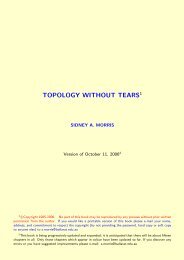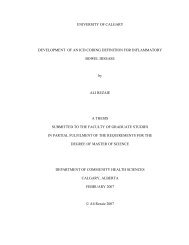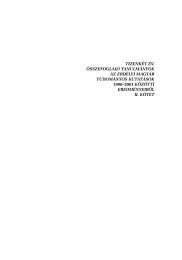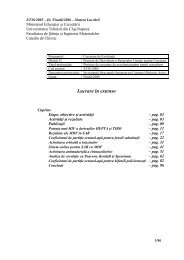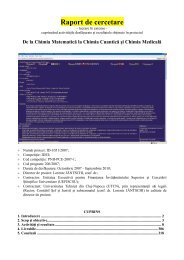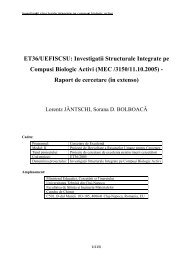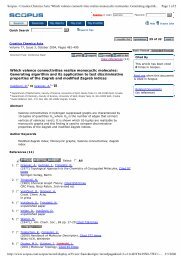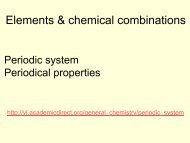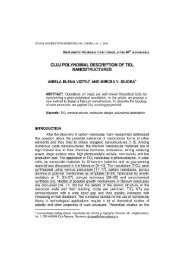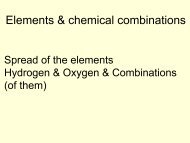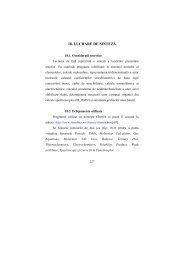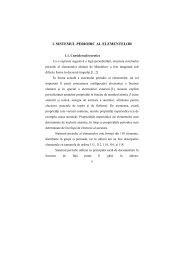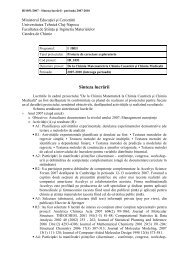Extraction and Planar Chromatographic Separation Techniques in the
Extraction and Planar Chromatographic Separation Techniques in the
Extraction and Planar Chromatographic Separation Techniques in the
You also want an ePaper? Increase the reach of your titles
YUMPU automatically turns print PDFs into web optimized ePapers that Google loves.
40<br />
solvent composition was optimised us<strong>in</strong>g TLC as a pilot method. A step gradient with<br />
<strong>in</strong>creas<strong>in</strong>g solvent strength was applied. MPLC was performed by fill<strong>in</strong>g <strong>the</strong> column first with<br />
approximately 50 g of dry silica <strong>and</strong> condition<strong>in</strong>g it with <strong>the</strong> elution solvent for <strong>the</strong> required<br />
time. The sample was dissolved <strong>in</strong> a small volume of solvent, applied on top of <strong>the</strong> column<br />
<strong>and</strong> <strong>the</strong> solvent flow was <strong>in</strong>itiated. A similar solvent comb<strong>in</strong>ation to that used <strong>in</strong> RPC was<br />
applied with a step gradient of <strong>in</strong>creas<strong>in</strong>g solvent strength. Fractions were collected us<strong>in</strong>g an<br />
automatic fraction collector.<br />
8.2.3.Screen<strong>in</strong>g of <strong>in</strong>dole derivatives by TLC <strong>and</strong> RPC (IV)<br />
For <strong>the</strong> TLC analysis <strong>the</strong> st<strong>and</strong>ards <strong>and</strong> samples were applied to <strong>the</strong> TLC silica plates as 2<br />
mm-wide b<strong>and</strong>s. 3 µL of st<strong>and</strong>ard <strong>and</strong> 3 to 5 µL of sample were applied at an application rate<br />
of 10 s µL -1 . The plates were developed <strong>in</strong> ascend<strong>in</strong>g mode <strong>in</strong> an unsaturated 10 cm × 20 cm<br />
tw<strong>in</strong> trough chamber at ambient temperature <strong>and</strong> protected from direct daylight. The<br />
development distance was 8 cm. The developed plates were dried at room temperature <strong>and</strong><br />
protected from light, <strong>and</strong> scanned at λ = 280 nm. The images of <strong>the</strong> plates were acquired with<br />
<strong>the</strong> Video Documentation System at λ = 254 nm. For <strong>the</strong> RPC analysis <strong>the</strong> st<strong>and</strong>ards <strong>and</strong><br />
samples were applied to <strong>the</strong> TLC silica plates <strong>in</strong> <strong>the</strong> form of a circle with a 500 µL syr<strong>in</strong>ge at<br />
a po<strong>in</strong>t ca. 2 cm from <strong>the</strong> center of <strong>the</strong> plate (Hamilton, Bonaduz, Switzerl<strong>and</strong>). The applied<br />
volume was 50 µL or 100 µL. The speed of rotation was 1700 rpm (57 Hz) <strong>and</strong> <strong>the</strong> solvent<br />
flow rate was varied between 0.6 mL/m<strong>in</strong> <strong>and</strong> 0.9 mL/m<strong>in</strong>. The mobile phase was identical<br />
with that used <strong>in</strong> <strong>the</strong> TLC procedure. Different development distances were tested, <strong>the</strong><br />
development time with <strong>the</strong>se sett<strong>in</strong>gs vary<strong>in</strong>g between 9 m<strong>in</strong> to 19 m<strong>in</strong>. All <strong>the</strong> separations<br />
were performed by normal chamber RPC (N-RPC), i.e. <strong>the</strong> vapor space was not elim<strong>in</strong>ated.<br />
The developed plates were dried, scanned <strong>and</strong> documented as described for <strong>the</strong> TLC analysis.<br />
8.2.4.Comparison of densitometer <strong>and</strong> video scanner <strong>in</strong> quantitative TLC (V)<br />
The st<strong>and</strong>ards <strong>and</strong> samples were applied as 6 mm b<strong>and</strong>s on silica HPTLC plates <strong>and</strong> RP-18<br />
TLC plates, <strong>and</strong> <strong>the</strong> rate of application was 10 s/µl. The mobile phases were optimized by<br />
means of <strong>the</strong> PRISMA system (NYIREDY et al. 1985, 1988). The separations were<br />
performed ei<strong>the</strong>r <strong>in</strong> an unsaturated tw<strong>in</strong> trough chamber for 10 cm × 20 cm plates, or <strong>in</strong> an<br />
unsaturated horizontal develop<strong>in</strong>g chamber for 10 cm × 20 cm plates. The analytes were<br />
detected by UV irradiation at 254 nm for flavonoids <strong>and</strong> phenolic acids, <strong>and</strong> by UV<br />
irradiation at 366 nm for coumar<strong>in</strong>s. The <strong>in</strong>fluence of <strong>the</strong> densitometer <strong>and</strong> video scanner<br />
<strong>in</strong>strument sett<strong>in</strong>gs on <strong>the</strong> quantitative results was studied <strong>and</strong> <strong>the</strong> two detection methods were<br />
compared.<br />
8.2.5.Assay for radical scaveng<strong>in</strong>g activity of phenolics by RP-TLC (VI)<br />
The st<strong>and</strong>ards were applied as 9 mm-wide b<strong>and</strong>s on RP-18 TLC plates us<strong>in</strong>g an application<br />
rate of 15 s/µl. The solvent system used was optimized for <strong>the</strong> separation of rapeseed meal<br />
extract accord<strong>in</strong>g to <strong>the</strong> PRISMA model (NYIREDY et al. 1985, 1988). The plates were



